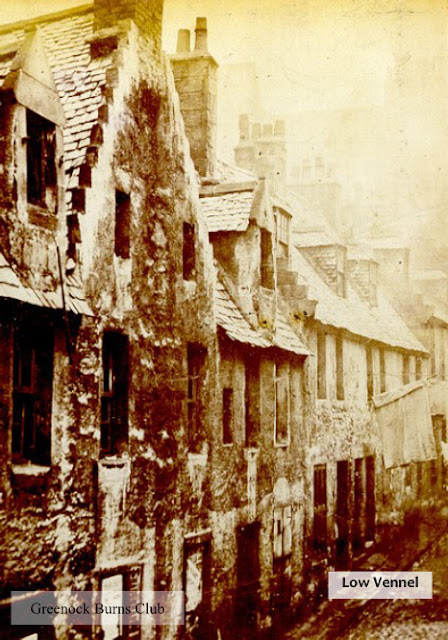On 7 April 1796 the Amsterdam packet left the harbour of Greenock on a voyage to New York. On board was David Downie and his four young children (Charles Stewart (born 1774) Mary Anne (born 1776) James Drummond (born 1787) and Margaret (born 1781)).
 |
| David Downie, Edinburgh |
As the ship left port, Downie knew that he would never be able to set foot in his native land ever again. He had been sentenced to be transported from Britain, never to return. His crime - high treason!
An Edinburgh goldsmith with premises in Parliament Square, David Downie had been tried in 1794 along with a co-conspirator Robert Watt (a government spy) for being part of what became known as the Pike Plot. Downie and Watt had joined a radical group called the Society of the Friends of the People and had planned to take Edinburgh Castle by force. They were both tried, found guilty and sentenced:
"The judgment of the Court was, that you Robert Watt, and you, David Downie, be taken from the Bar to the place from whence you came, and from thence to be drawn upon a Hurdle to the place of execution, there to be hanged by the neck, but not till you are dead, for then you are to be taken down, your Hearts to be cut out, and your Bowels burned before your Faces, your Heads and Limbs severed from your bodies and held up to public view, and your bodies shall remain at the disposal of his majesty, and the Lord have mercy on your Souls."

Both were imprisoned in Edinburgh Castle. Watt was hanged and beheaded. Downie, after a year in prison, had his sentenced commuted. On Saturday 19 March 1796 it was reported that Downie had
been released from Edinburgh Castle by a remission granted by the King on the
recommendation of the Jury. The
conditions were that he “shall depart from His Majesty’s Dominions of Great
Britain and Ireland within ten days after being set at liberty, and never be
found therein during all the days of his natural life, under pain of the former
sentence being put into execution against him; unless he shall obtain a licence
for that purpose under the Royal Sign Manual."
Downie was taken to Greenock to board a ship to America. His family met him in the town. He wrote to a friend after arriving in New York and the letter was published in Bell's Weekly Messenger.
"From Mr David Downie, late Goldsmith in Edinburgh. (Who was found guilty of High Treason) to a Friend in Perth,
dated New York, June 22, 1796.
“Dear Sir.
On the 7th April, when I had the pleasure of writing you
from Greenock, we set sail in the Amsterdam Packet, Captain Charles Henderson,
a humane good man, and a prudent sailor, to whom we were much obliged for his
attention on the voyage. After clearing
the land, with a fair wind in eight days we had the wind a-head for 21 days;
notwithstanding which, by coursing to the N. and S. we made 800 miles, the wind
still against us; but on the 9th of April, we were obliged to lie-to for 24
hours, lash the helm, and leave the ship to the mercy of the wind and
waves. At this period we experienced
sundry trials, but all kept perfect health, except my eldest daughter, who was
sea-sick.
After this, we experienced great vicissitudes of fair and
cold, according to the different latitudes we were in. From the 1st of May we
had tolerably fair wind; and arrived on the 28th just at the very spot the
Captain wished.
Finding the necessaries of life at an exorbitant cost
occasioned by the demand of the Powers at War, we found a room, and furnished
ourselves ... I have been at Philadelphia, partly by land, and by water,
to enable me to judge of the country, where I shall finally settle. By the
assistance of Mr. Napper Tandy, a keen old man, about 70, I have found my good
friend, Mr. Stock ... By his kindness my eldest
daughter is gone to the family of Mr. Dallas, Secretary to the State of
Pennsylvania, to teach his children music, French, &c. I have hopes too of
young Charles a situation here. The other two and my wife go to Georgia, where
I can both exercise my business, and purchase from 300 to 500 acres, which I
will improve as ability may permit. They are called prime or first-rate lands,
to be disposed of at 5s. per acre.
You will judge me ill qualified to give an opinion of
America, being only 24 days an inhabitant; but this I venture to affirm, that
it is a poor man’s country. ... A dollar is not
valued here more than a shilling is in Britain.
The body of the People have the whole power
of management. They can put in and put
out whom they please, without control.
An instance of this we have just now, a Carman, or, as you call them in
your country, a common Carter as a Representative of this city; his name is
Lamb.
Please remember me to all your good neighbours, who have
been my trusty friends.
I am, etc
David Downie"

David Downie settled in Augusta, Georgia and died there in 1816. Read more about David Downie here.
Just before the ship Amsterdam sailed from Greenock, a Bow Street Runner arrested an arsonist from London who was trying to evade the law and sail to America! Read about it here!




.JPG)

.JPG)
.JPG)













